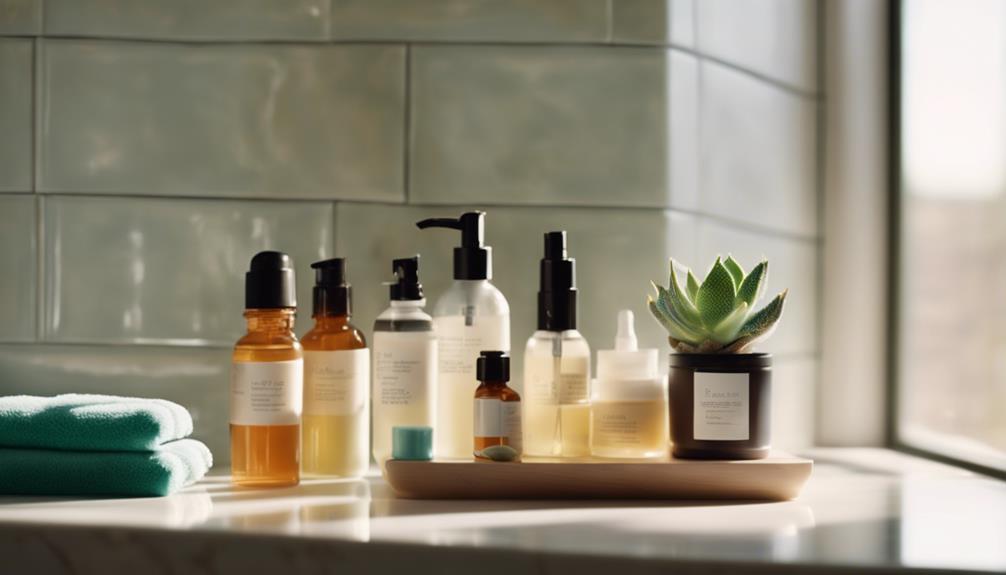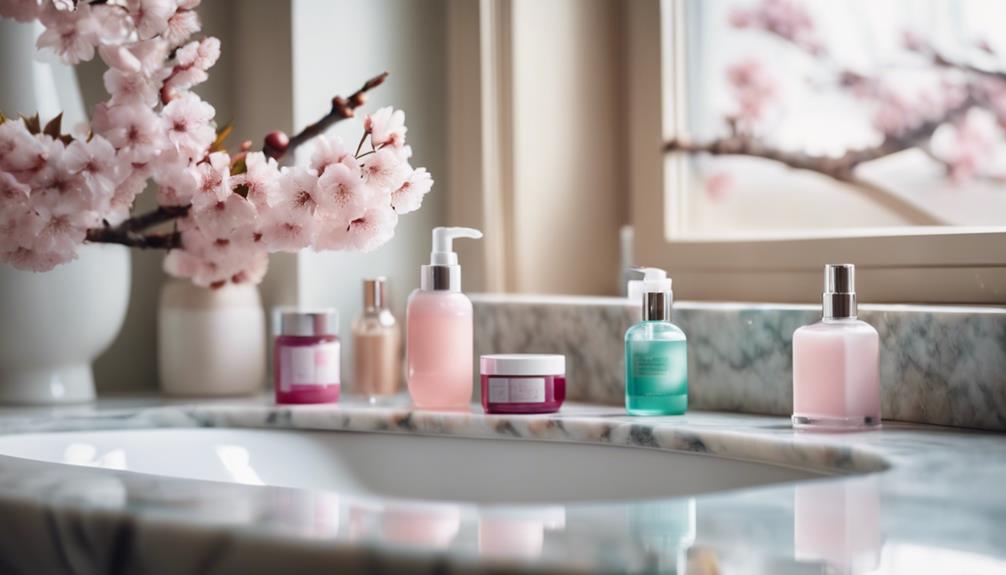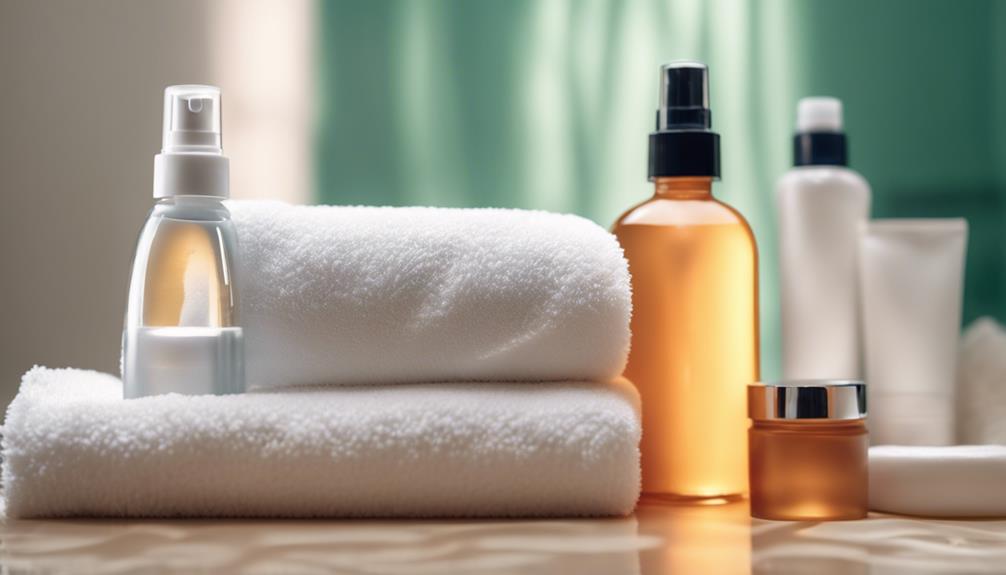A proper 10-step skincare regimen is crucial in achieving flawless skin. Begin by cleansing to rid your skin of dirt and prepare it for the next steps. Then, exfoliate to keep your skin smooth and even out its pH balance. Keeping your skin hydrated is essential, so make sure to apply a suitable moisturizer after toning. Don’t skip sunscreen to protect against UV damage. Include weekly treatments tailored to your skin’s specific needs and adjust your routine as needed. Consistency is key for seeing long-term results, so stay committed. By following these guidelines, you’ll improve the health and appearance of your skin. There’s still more to learn about perfecting your routine!
Key Takeaways
- Follow the correct application order, starting with thinnest products like toners and serums for optimal absorption and effectiveness.
- Cleanse daily with a suitable cleanser to remove impurities and prepare the skin for subsequent products.
- Incorporate exfoliation 1 to 3 times a week to promote smoother skin and enhance product absorption.
- Use a hydrating toner to restore pH balance and improve moisture levels, setting the stage for better serum and moisturizer effectiveness.
Importance of Application Order
When you apply your skincare products in the right order, you greatly boost their effectiveness and guarantee your skin reaps the full benefits. The application order is vital because it determines how well each product penetrates your skin.
Starting with the thinnest products, like toners and serums, allows these lightweight formulations to absorb deeply, delivering active ingredients effectively. If you layer heavier creams and oils first, you risk creating a barrier that prevents lighter products from doing their job.
Following the recommended application order maximizes the benefits you receive from each item in your routine. It's important to adjust your routine based on your skin type and product formulation, as not all products fit neatly into the standard order. For instance, some treatments may need to be applied differently to achieve the best results.
Neglecting this correct application order can lead to decreased effectiveness of your skincare products, hindering your desired results and skin health improvements. By prioritizing the right sequence, you'll make sure that your skin gets everything it needs to look and feel its best.
First Step: Cleansing
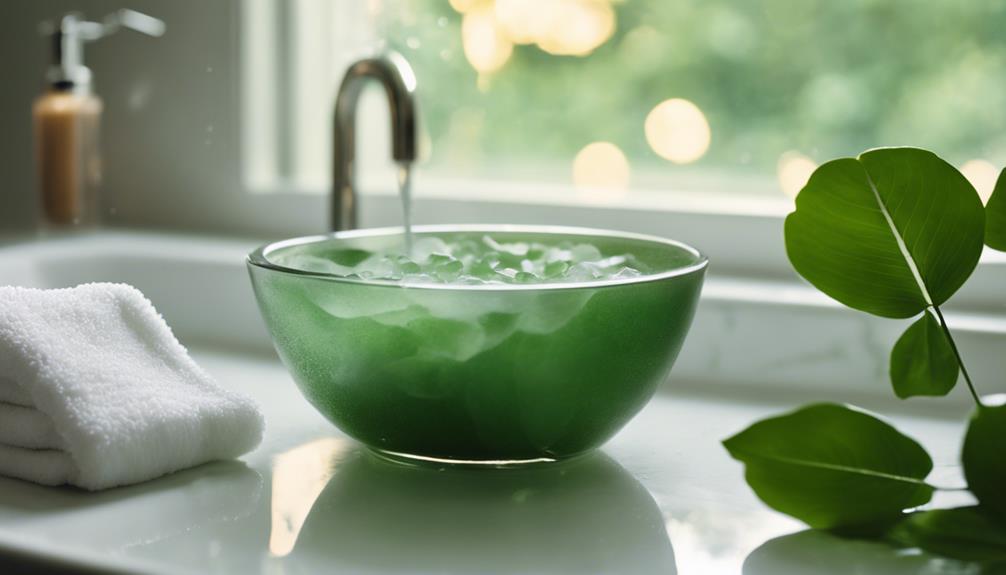
Cleansing is the foundation of any effective skincare routine, and you shouldn't skip it.
You'll want to choose a cleanser that suits your skin type and use proper techniques to guarantee your skin feels fresh and clean.
Let's explore why daily cleansing is essential and how to get it right.
Importance of Daily Cleansing
Daily cleansing plays an essential role in keeping your skin healthy by effectively removing dirt, oil, and impurities that can lead to breakouts. By incorporating daily cleansing into your skincare routine, you're not just cleaning your skin; you're also preparing it for the products that follow, enhancing their absorption and efficacy.
To make the most of your cleansing routine, it's vital to understand different techniques and recommendations. Here's a quick overview to guide you:
| Cleansing Technique | Benefit |
|---|---|
| Use lukewarm water | Opens pores for better cleansing |
| Circular motion | Enhances cleansing effectiveness |
| Double cleansing | Removes heavy makeup and sunscreen |
Cleansing twice daily is recommended, using gentle cleansers suited to your skin type. For example, gel cleansers work well for oily skin, while cream cleansers are ideal for dry skin. This consistent practice not only helps prevent clogged pores but also promotes clearer, healthier skin. Remember, daily cleansing is the foundation of any effective skincare routine!
Choosing the Right Cleanser
Selecting the right cleanser is essential for effectively removing impurities and keeping your skin clear and healthy. A good cleanser helps eliminate dirt, oil, and makeup, preventing clogged pores and breakouts.
If you have oily skin, consider using gel cleansers or foaming formulas. These types help control excess oil and provide a deep clean, leaving your skin feeling fresh.
For those with dry skin, cream or hydrating cleansers are your best bet. Look for products containing moisturizing ingredients to avoid stripping your skin of its natural oils.
If your skin is combination, opt for a gentle, balanced cleanser that addresses both oily and dry areas without causing irritation.
No matter your skin type, always choose a pH-balanced cleanser. This helps maintain your skin's natural barrier and prevents disruption of its microbiome, which is vital for overall skin health.
Cleansing Techniques for Effectiveness
To achieve effective cleansing, start by rinsing your face with lukewarm water to open up your pores and prepare your skin for the cleanser. This initial step is essential for maximizing the benefits of your skin-care products.
Choose a cleanser that suits your skin type and apply it using gentle circular motions. This technique helps lift away dirt, oil, and makeup without causing irritation.
Focus on areas prone to oil buildup, like your nose and jawline, ensuring thorough cleansing for best results.
If you wear heavy makeup or sunscreen, consider double cleansing. Begin with an oil-based cleanser to break down stubborn products, then follow up with a water-based cleanser to remove any remaining residue.
Exfoliation Techniques
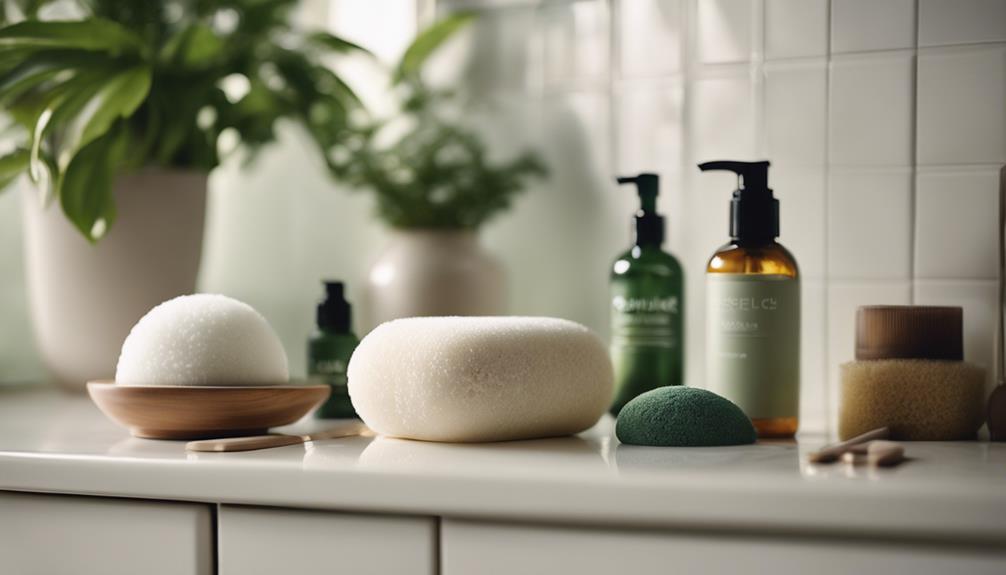
Exfoliating your skin is essential for achieving a smoother complexion and can be done effectively using either physical or chemical techniques.
Physical exfoliation involves using scrubs, brushes, or sponges to manually slough off dead skin cells. This method is great for those who enjoy a hands-on approach, but be cautious; over-scrubbing can lead to irritation.
On the other hand, chemical exfoliation employs acids like glycolic or salicylic acid to dissolve dead skin cells, providing deeper skin renewal. Many find chemical exfoliants more beneficial, particularly if you're looking to reduce fine lines and unclog pores.
If you have sensitive skin, you'll want to choose gentler exfoliation techniques, such as enzymatic exfoliators, to avoid irritation and maintain your skin barrier.
When it comes to frequency, aim to exfoliate 1 to 3 times a week, adjusting based on your skin type. Oily skin can generally handle more frequent exfoliation, while dry or sensitive types should stick to less.
Incorporating exfoliation into your routine not only helps achieve smoother skin but also enhances the absorption of serums and moisturizers, boosting your overall skin health.
The Role of Toning

Toning's a vital step in your skincare routine that helps restore your skin's pH balance after cleansing.
It removes any leftover dirt or oil, ensuring your skin is completely clean and ready for the next products.
Plus, using a toner can enhance the absorption of your serums and moisturizers, making them more effective.
Ph Balance Restoration
Restoring your skin's natural pH balance is essential after cleansing, and using a toner can effectively achieve this. Cleansers, especially those that are too alkaline, can disrupt your skin's delicate pH levels. A well-formulated toner helps correct this imbalance, ensuring your skin feels refreshed and healthy.
Moreover, toners can remove any residual dirt, oil, and makeup left behind after cleansing, ensuring your skin is thoroughly clean. This step is vital for maintaining a clear complexion. Many toners also include hydrating ingredients like glycerin or hyaluronic acid, which not only provide moisture but also enhance your skin's texture while balancing pH.
Regular use of toner can lead to a more radiant complexion and even help minimize the appearance of pores over time. By incorporating this essential product into your routine, you're not just cleaning your skin; you're prepping it for the next steps in your skincare regimen.
Enhanced Product Absorption
After using a toner to balance your skin's pH, you're setting the stage for enhanced product absorption, allowing your serums and moisturizers to penetrate more effectively. Toning is essential in your skincare routine because it restores your skin's natural balance, creating an ideal environment for product effectiveness. When your skin's pH is optimal, the active ingredients in your favorite serums and moisturizers can work their magic.
Most toners also contain hydrating ingredients like hyaluronic acid, which adds an extra layer of moisture. This not only hydrates your skin but also helps prepare it for better absorption of subsequent products. The more hydrated your skin is, the more receptive it becomes to the active ingredients you're applying.
Moreover, regular use of toner can help you choose the right formulation for your specific skin type, ensuring that you're addressing your unique skincare needs. By incorporating a suitable toner into your skincare routine, you'll enhance the absorption of all your products, resulting in a more effective and radiant complexion.
Embrace toning as an essential step in achieving the flawless skin you desire.
Residual Dirt Removal
Using a toner effectively removes any residual dirt, oil, and makeup that your cleanser may have missed, ensuring your skin is thoroughly clean. This step is essential for achieving ideal residual dirt removal, as even the best cleansers can leave behind traces that could clog your pores or lead to breakouts.
In addition to cleaning, toners help restore your skin's natural pH balance, which can get disrupted during cleansing. This balance is important for maintaining healthy skin, as it allows your skin to function properly and fend off environmental aggressors.
Moreover, using a toner enhances the absorption of your next skincare products, making them more effective. Many toners also contain hydrating ingredients, offering an extra layer of moisture that can help plump your skin.
Regularly incorporating a toner into your routine can greatly improve your skin texture and clarity, contributing to a more radiant complexion. So, don't skip this critical step! By prioritizing residual dirt removal with a toner, you're setting the foundation for healthier, more luminous skin.
Targeting Specific Skin Concerns

To effectively tackle specific skin concerns like acne or wrinkles, you'll want to choose products packed with active ingredients designed for your unique needs. For acne, look for formulations containing salicylic acid, which helps unclog pores and reduce inflammation. If you're focused on aging skin, consider incorporating retinoids, known for their ability to boost cell turnover and diminish fine lines.
When targeting specific skin concerns, consistency is key. Applying targeted treatments, such as serums or spot treatments, regularly over at least six weeks is essential to see visible results. It's also important to select products based on your skin type; oily skin often benefits from lightweight, oil-free options, while dry skin requires richer, hydrating formulas.
Don't hesitate to consult a dermatologist for personalized recommendations tailored to your skin's unique issues and sensitivities. Additionally, incorporating a blend of preventative and corrective treatments, like antioxidants and exfoliating acids, can greatly enhance your overall skin health.
Hydration and Moisturization
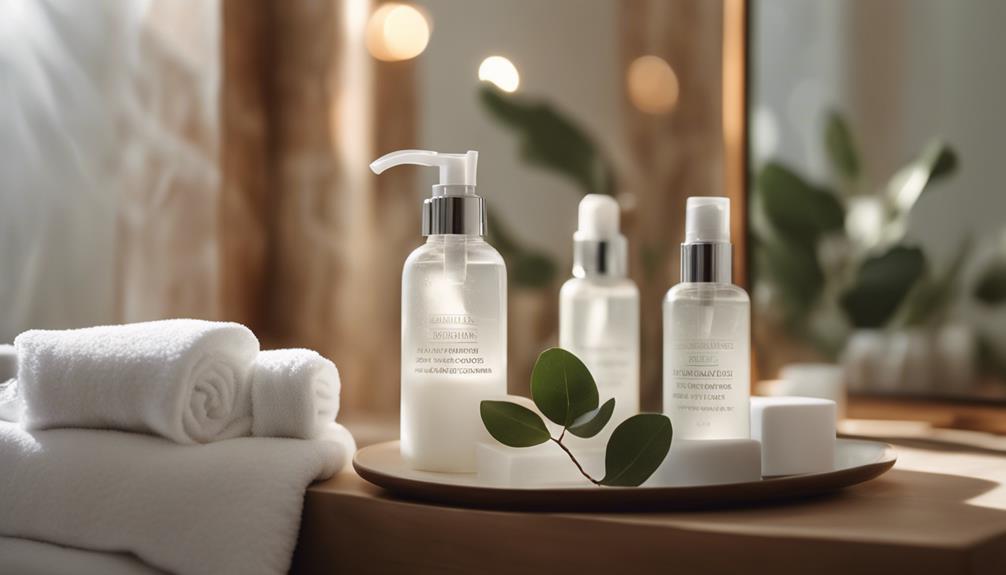
Hydration and moisturization play an essential role in keeping your skin looking youthful and supple. To achieve ideal hydration, focus on using ingredients like hyaluronic acid, which can hold up to 1,000 times its weight in water. This powerful ingredient draws moisture deep into your skin, enhancing plumpness and elasticity.
When you apply your moisturizer, do it while your skin is still slightly damp. This simple step boosts absorption, ensuring that your skin retains maximum hydration. Remember, different skin types need tailored approaches. If you have oily skin, lightweight, oil-free moisturizers are your best bet, while richer creams are perfect for dry skin types.
Regularly using a moisturizer not only hydrates but also helps prevent transepidermal water loss. This is essential for maintaining your skin's barrier function and overall health.
Finally, don't forget that incorporating daily sunscreen (SPF 30+) is important. It shields your skin from UV damage and helps prevent moisture loss, keeping your skin youthful longer.
Daily Sun Protection

Daily sun protection is essential for keeping your skin healthy and preventing premature aging.
You should apply broad-spectrum sunscreen with at least SPF 30 generously and reapply it every two hours for maximum effectiveness.
Understanding the right application techniques can make all the difference in safeguarding your skin from harmful UV rays.
Importance of SPF
Applying SPF every day is essential for protecting your skin from harmful UV rays that can cause premature aging and increase the risk of skin cancer.
Using sunscreen with at least SPF 30 is critical, as it effectively shields your skin from both UVA and UVB rays. UVA rays penetrate deeper, contributing to wrinkles and skin laxity, while UVB rays are primarily responsible for sunburn.
Regularly applying sunscreen can greatly reduce your risk of developing melanoma and other skin cancers. Studies show that consistent use can lower melanoma risk by up to 50%. To guarantee maximum protection, apply a generous amount of sunscreen and reapply it every two hours, or immediately after swimming or sweating.
Incorporating SPF into your daily skincare routine not only guards against sun damage but also helps you maintain an even skin tone and prevents hyperpigmentation.
By prioritizing daily sun protection, you're investing in your skin's health and longevity. Remember, the commitment to using sunscreen every day is a simple yet powerful step toward achieving flawless skin.
Don't underestimate the importance of SPF—it's a crucial part of your skincare regimen.
Application Techniques
Mastering the application techniques for sunscreen can greatly enhance your daily sun protection routine. Start with a broad-spectrum sunscreen that has at least SPF 30, protecting you from both UVA and UVB rays. To apply, use a nickel-sized amount for your face and spread it evenly over all exposed skin. Don't forget areas like your ears, neck, and the back of your hands!
Incorporate this step into your morning skincare routine after applying moisturizer. Allow the sunscreen to absorb for at least 15 minutes before stepping outside. This wait time guarantees that you get the maximum protection from harmful UV rays.
Reapplication is key, so plan to refresh your sunscreen every two hours, especially if you're swimming or sweating. Whether you're heading to the beach or running errands, staying consistent with your sunscreen application will help prevent skin damage, hyperpigmentation, and reduce the risk of skin cancer.
Incorporating Weekly Treatments
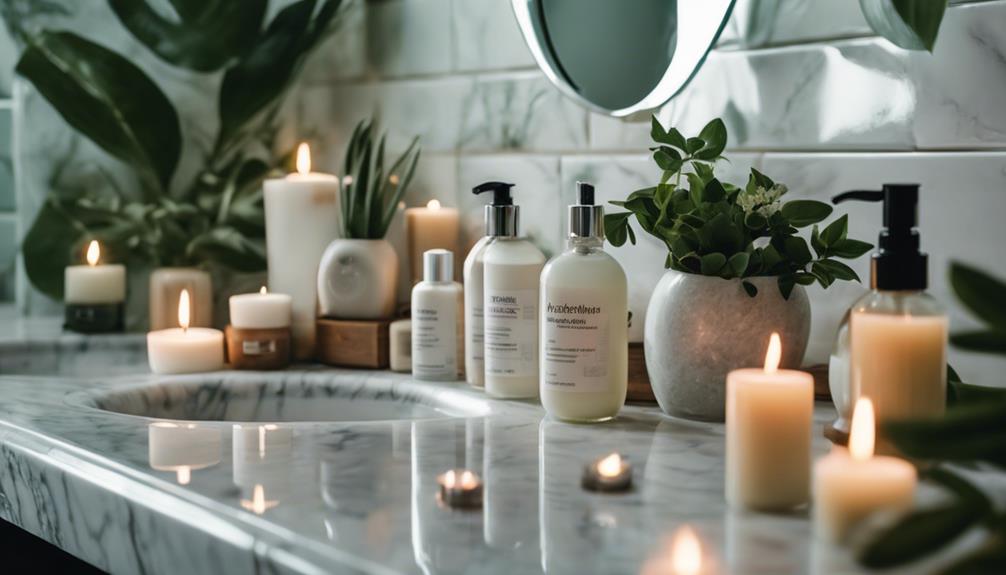
Incorporating weekly treatments into your skincare routine can considerably elevate your skin's health and appearance by targeting specific concerns and enhancing overall texture. Weekly treatments like exfoliating masks, hydrating masks, and targeted spot treatments can make a significant difference in your skin's quality.
| Treatment Type | Benefits |
|---|---|
| Exfoliating Masks | Removes dead skin cells, promotes cell turnover, leads to smoother complexion |
| Hydrating Masks | Replenishes moisture, enhances skin plumpness, ideal for dry skin types |
| Spot Treatments | Targets stubborn acne, contains active ingredients, prevents over-drying |
Using a retinol treatment once a week can also improve signs of aging, such as fine lines and uneven skin tone. Keep in mind that it's essential to monitor your skin's reactions when introducing these weekly treatments. Adjust the frequency and product types based on your skin's sensitivity and needs for the best results. By doing so, you'll enjoy healthier, more radiant skin while addressing specific issues effectively.
Adjusting Based on Skin Response

Regularly evaluating your skin's response to products guarantees your routine remains effective and tailored to your needs. Your skin can change due to factors like weather, hormones, or stress, so it's crucial to stay attentive.
Here are some tips for adjusting based on skin response:
- Monitor for Irritation: If you notice redness or breakouts, consider reducing the frequency of active ingredients like retinol or exfoliating acids. Switch to gentler formulations when needed.
- Assess Hydration Levels: If your skin feels tight or dry, it's a sign you may need more hydration. Look for more moisturizing formulas that suit your skin concerns.
- Keep a Skincare Journal: Track changes in your skin's condition over time. This will help you identify patterns or triggers that indicate necessary adjustments.
- Consult a Dermatologist: If you face persistent issues, don't hesitate to seek personalized recommendations from a professional, as they can provide insights tailored to your specific skin needs.
Consistency for Long-Term Results

Maintaining consistency in your skincare routine is key to achieving long-term results and healthier skin. When you apply your products daily, you allow your skin to build resilience and improve its overall health. It typically takes at least six weeks of consistent use to notice visible improvements, so patience is vital.
To reinforce your skin health, establish a daily routine that includes cleansing, toning, and moisturizing both morning and night. This regularity guarantees your skin receives the care it needs to maintain its appearance. Remember, your skin can change due to age or environmental factors, so it's essential to reassess its needs periodically. Adjusting your products accordingly promotes effective outcomes.
To enhance your consistency, consider keeping a skincare journal. Tracking product effectiveness can help you identify what works best for your skin, allowing for informed adjustments based on your observations. By focusing on consistency, you're investing in your skin's future and paving the way for a flawless complexion. Stick with it, and you'll reap the rewards of your diligent efforts.
Can a 7 Step Skincare Routine Provide the Same Benefits as a 10 Step Routine for Flawless Skin?
Yes, a 7 step skincare routine can provide the same benefits as a 10 step routine for flawless skin. By focusing on the most essential and effective comprehensive skincare routine steps, you can still achieve glowing, healthy skin without the need for additional steps. Quality over quantity is key.
Conclusion
By following this 10-step skincare routine, you're setting yourself up for radiant, flawless skin.
Remember, consistency is key—your skin thrives on regular care and attention.
Have you considered how each step contributes to your overall skin health?
With a little patience and dedication, you'll not only address specific concerns but also maintain a vibrant complexion for the long haul.
Embrace the journey, and let your skin glow with confidence!
